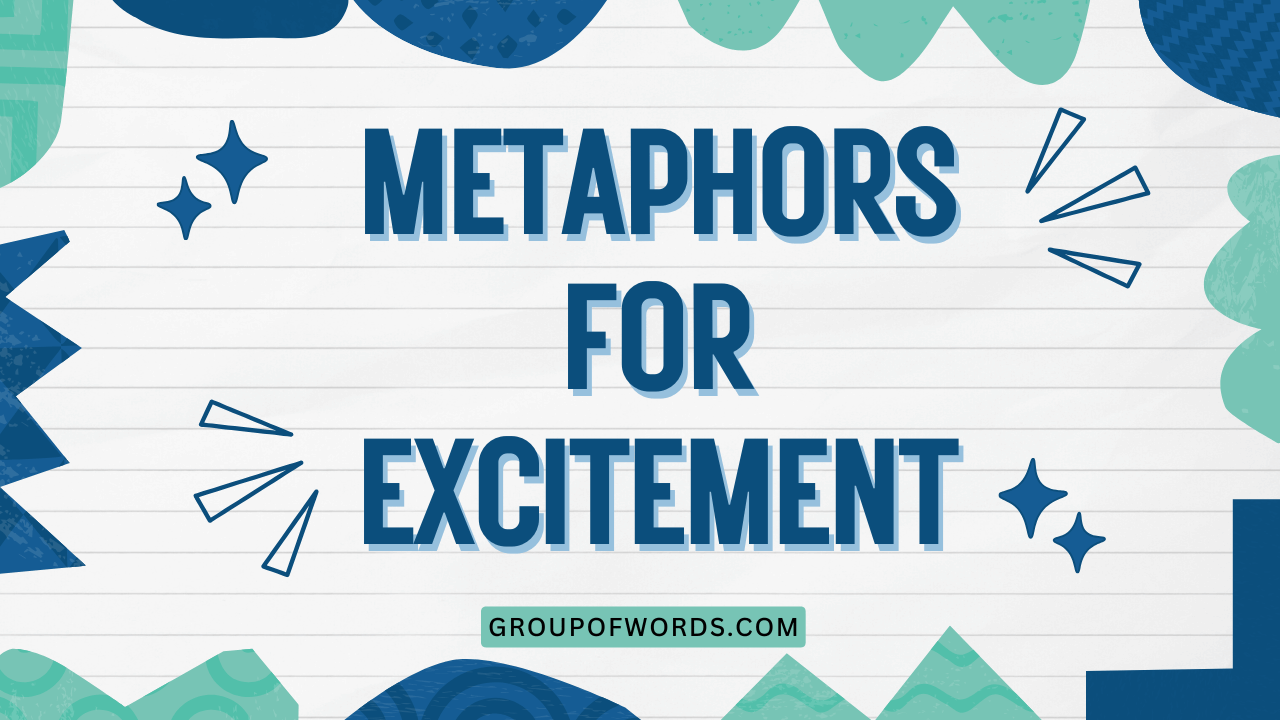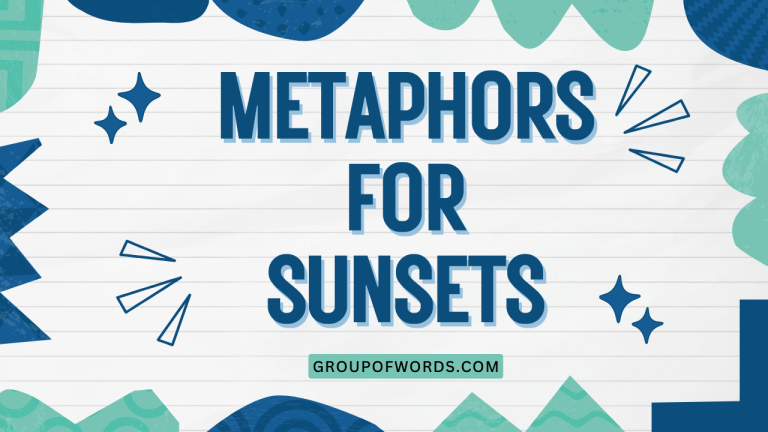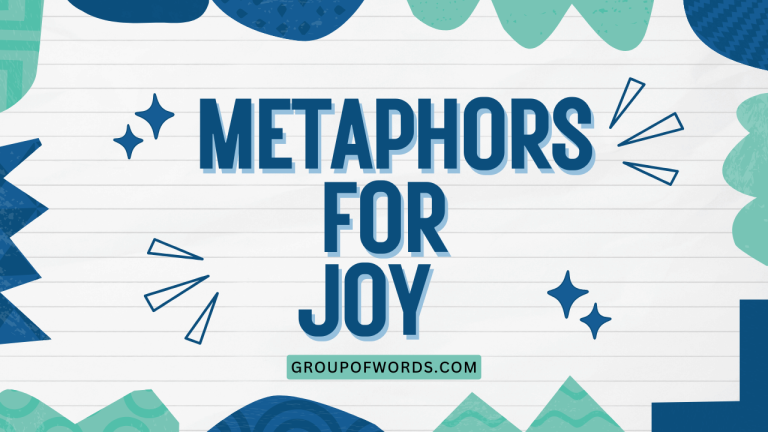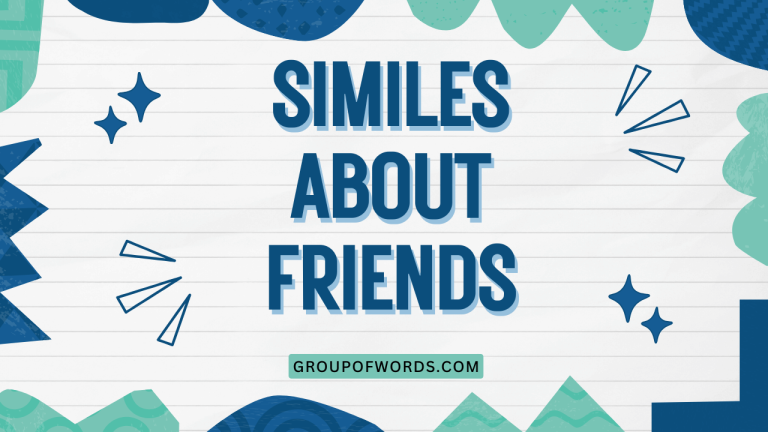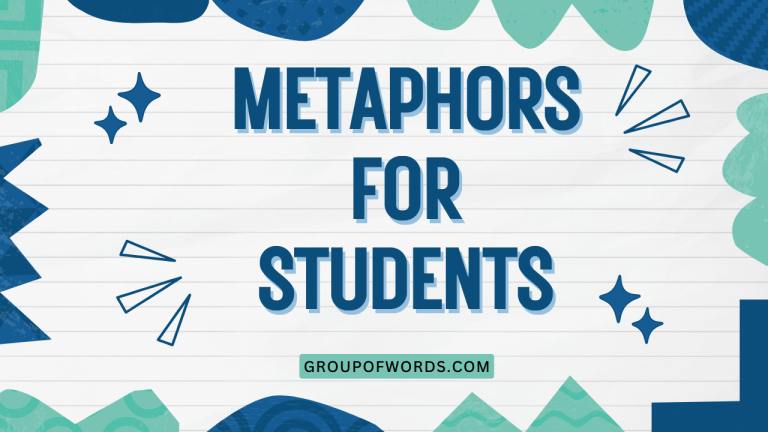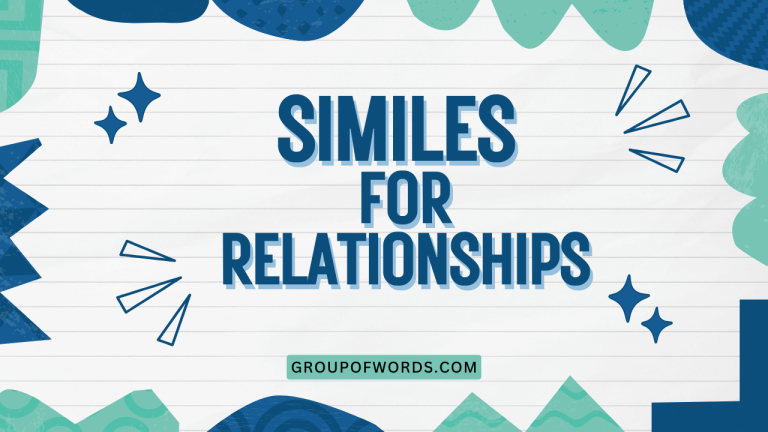Metaphors for Excitement: A Comprehensive Guide
Understanding metaphors is crucial for mastering the nuances of the English language. Metaphors allow us to express complex emotions and ideas in vivid and relatable ways.
This article delves into the fascinating world of metaphors used to describe excitement, a powerful emotion that fuels our passions and drives our actions. By exploring various types of excitement metaphors, their structures, and usage rules, you’ll gain a deeper appreciation for the richness and versatility of the English language.
This guide is beneficial for English language learners, writers, and anyone interested in enhancing their communication skills and creative expression.
This comprehensive guide provides a detailed exploration of metaphors for excitement. It covers definition, structural elements, types, examples, usage rules, common mistakes, and practice exercises.
Whether you are a language learner, a writer, or simply someone who appreciates the beauty of language, this article will equip you with the knowledge and skills to effectively use metaphors to convey excitement.
Table of Contents
- Introduction
- Definition of Metaphor for Excitement
- Structural Breakdown
- Types and Categories of Excitement Metaphors
- Examples of Excitement Metaphors
- Usage Rules for Excitement Metaphors
- Common Mistakes with Excitement Metaphors
- Practice Exercises
- Advanced Topics
- FAQ
- Conclusion
Definition of Metaphor for Excitement
A metaphor for excitement is a figure of speech that compares excitement to something else, suggesting a similarity without using “like” or “as.” It allows us to express the intensity, energy, and exhilaration of excitement in a more vivid and imaginative way. Metaphors are essential for adding depth and color to our language, making it more engaging and impactful.
Metaphors work by transferring qualities from one concept (the source) to another (the target). In the case of excitement metaphors, the abstract feeling of excitement is described using concrete, relatable images or sensations.
This helps the audience grasp the emotional intensity and understand the speaker’s perspective more effectively.
The function of excitement metaphors is multifaceted. They can intensify emotions, create vivid imagery, simplify complex feelings, and add stylistic flair to writing and speech.
By using metaphors, we can transform ordinary descriptions into extraordinary expressions of feeling.
Structural Breakdown
The basic structure of a metaphor involves two key elements: the tenor (or topic) and the vehicle. The tenor is the subject being described (in this case, excitement), and the vehicle is the object or concept to which it is being compared. The connection between the tenor and the vehicle is the ground, which refers to the shared characteristics that make the metaphor meaningful.
For example, in the metaphor “Her excitement was a volcano about to erupt,” the tenor is “her excitement,” and the vehicle is “a volcano about to erupt.” The ground is the shared characteristic of intense, pent-up energy that is about to be released. This structure allows the metaphor to effectively convey the overwhelming and potentially explosive nature of her excitement.
Effective metaphors also rely on context. The meaning and impact of a metaphor can change depending on the situation and the audience. A metaphor that resonates with one person might not have the same effect on another. Therefore, it is crucial to consider the context when choosing and interpreting metaphors for excitement.
Types and Categories of Excitement Metaphors
Excitement metaphors can be categorized based on the types of images and sensations they evoke. Here are some common categories:
Physical Sensation Metaphors
These metaphors relate excitement to physical feelings like tingling, buzzing, or a rush of adrenaline. They emphasize the body’s response to intense emotion.
Speed and Motion Metaphors
These metaphors describe excitement in terms of rapid movement or acceleration. They capture the feeling of being swept away by enthusiasm and anticipation.
Light and Energy Metaphors
These metaphors associate excitement with brightness, radiance, and intense energy. They highlight the positive and invigorating aspects of excitement.
Explosive Force Metaphors
These metaphors compare excitement to explosions, eruptions, or other displays of powerful force. They convey the overwhelming and potentially uncontrollable nature of intense excitement.
Height and Elevation Metaphors
These metaphors use images of height, elevation, or ascent to describe excitement. They suggest a feeling of exhilaration, triumph, and being lifted above the ordinary.
Examples of Excitement Metaphors
Here are some specific examples of excitement metaphors, categorized by type:
Physical Sensation Examples
Physical sensation metaphors are useful for creating a visceral understanding of excitement. They help the reader feel the emotion in their own body.
The following table provides examples of metaphors that describe excitement using physical sensations:
| Metaphor | Explanation |
|---|---|
| Her excitement was a buzzing in her veins. | Compares excitement to a tingling, energetic sensation. |
| Anticipation sent shivers of excitement down his spine. | Associates excitement with a physical chill or tremor. |
| The news gave her a jolt of pure excitement. | Describes excitement as a sudden, sharp sensation. |
| His heart thrummed with excitement. | Compares excitement to a rhythmic, pulsating sensation. |
| A tingling wave of excitement washed over her. | Associates excitement with a gentle, pervasive sensation. |
| The announcement caused a fluttering in her stomach. | Describes excitement as a nervous, light sensation. |
| His palms were sweaty with excitement. | Connects excitement to a physical manifestation of nervousness. |
| She felt a rush of excitement coursing through her. | Compares excitement to a sudden surge of energy. |
| A prickling sensation of excitement ran up his arms. | Describes excitement as a subtle, stimulating feeling. |
| Her breathing became shallow with excitement. | Associates excitement with a change in physical state. |
| His muscles tensed with excitement. | Connects excitement to a physical readiness for action. |
| She felt a knot of excitement in her chest. | Describes excitement as a concentrated, intense feeling. |
| His voice was tremulous with excitement. | Associates excitement with a shaky, unsteady quality. |
| She felt electric with excitement. | Compares excitement to a vibrant, energetic sensation. |
| His skin prickled with anticipation and excitement. | Describes excitement as a stimulating physical response. |
| The thrill sent goosebumps racing across her skin. | Connects excitement to a visible physical reaction. |
| Her senses were heightened with excitement. | Associates excitement with increased awareness. |
| He felt a surge of adrenaline fueled excitement. | Compares excitement to a hormonal response. |
| She was vibrating with excitement. | Describes excitement as an intense, energetic sensation. |
| His blood raced through his veins with excitement. | Compares excitement to rapid blood flow. |
| Her face was flushed with excitement. | Associates excitement with a visible physical change. |
| He felt a tightness in his throat from excitement. | Describes excitement as a constricting sensation. |
| She was quivering with excitement. | Compares excitement to a slight trembling. |
| His stomach was in knots with anticipation and excitement. | Describes excitement as a feeling of nervousness. |
Speed and Motion Examples
Speed and motion metaphors capture the dynamic and forward-moving aspect of excitement.
The table below illustrates how excitement can be described using speed and motion metaphors:
| Metaphor | Explanation |
|---|---|
| Her excitement was a runaway train, unstoppable and fast. | Compares excitement to something that is out of control and rapidly moving. |
| Anticipation propelled him forward with excitement. | Associates excitement with a driving force. |
| The news sent his excitement soaring. | Describes excitement as rising rapidly. |
| Her heart raced with excitement. | Compares excitement to rapid movement. |
| He was swept away by a wave of excitement. | Associates excitement with being carried along by a powerful force. |
| Her excitement was building momentum with each passing moment. | Describes excitement as gaining speed and intensity. |
| He felt his excitement accelerate as the moment approached. | Compares excitement to increasing speed. |
| Her dreams were catapulting her into a state of excitement. | Associates excitement with being launched forward. |
| He was carried along by the current of excitement. | Compares excitement to a flowing force. |
| Her enthusiasm spiraled into a vortex of excitement. | Describes excitement as a swirling, intensifying force. |
| He felt his excitement take flight. | Associates excitement with the act of flying. |
| Her anticipation was a roller coaster of excitement. | Compares excitement to a series of ups and downs. |
| His excitement surged through him like a tidal wave. | Describes excitement as a powerful, overwhelming force. |
| She was whisked away on a cloud of excitement. | Associates excitement with being transported to a different place. |
| His spirits lifted with excitement. | Compares excitement to rising upward. |
| The prospect launched him into a frenzy of excitement. | Associates excitement with being propelled into action. |
| Her imagination ran wild with excitement. | Describes excitement as unrestrained and uncontrolled. |
| He felt his hopes take off like a rocket with excitement. | Compares excitement to a rapid ascent. |
| She was adrift in a sea of excitement. | Associates excitement with being lost in a vast emotion. |
| His anticipation was a speeding train headed for joy. | Compares excitement to a fast, unstoppable journey. |
| The news made her excitement leap. | Describes excitement as a sudden jump. |
| Her excitement galloped forward, untamed and free. | Associates excitement with unrestricted movement. |
| He was drawn in by the vortex of thrilling anticipation. | Compares excitement to an irresistible pull. |
| She felt her world spinning with pure, unadulterated excitement. | Describes excitement as a dizzying sensation. |
Light and Energy Examples
Light and energy metaphors highlight the radiant and invigorating aspects of excitement.
The following table provides examples of metaphors that describe excitement using light and energy:
| Metaphor | Explanation |
|---|---|
| Her eyes sparkled with excitement. | Compares excitement to a bright, shining light. |
| Anticipation lit up his face with excitement. | Associates excitement with illumination. |
| The news electrified the crowd with excitement. | Describes excitement as a powerful, energizing force. |
| Her enthusiasm was a beacon of excitement. | Compares excitement to a guiding light. |
| He was glowing with excitement. | Associates excitement with radiance. |
| Her excitement was a fire burning within her. | Describes excitement as an intense, consuming energy. |
| He felt a surge of energy and excitement. | Compares excitement to a powerful flow of energy. |
| Her spirit shone with excitement. | Associates excitement with inner radiance. |
| He was charged up with excitement. | Describes excitement as being full of energy. |
| Her laughter was bright with excitement. | Compares excitement to a cheerful light. |
| He felt a spark of excitement ignite within him. | Associates excitement with a sudden burst of energy. |
| Her words were radiant with excitement. | Describes excitement as shining brightly. |
| He was ablaze with excitement. | Compares excitement to a burning fire. |
| Her enthusiasm was a sunbeam of excitement. | Associates excitement with warmth and brightness. |
| He felt a jolt of pure, unadulterated excitement. | Describes excitement as a sudden electric shock. |
| Her presence illuminated the room with her excitement. | Associates excitement with brightness and positivity. |
| He was energized by the sheer excitement of the moment. | Compares excitement to an invigorating power source. |
| Her smile lit up the room with pure excitement. | Associates excitement with a radiant expression. |
| He felt his inner light shining with excitement. | Describes excitement as an internal source of brightness. |
| Her excitement was a powerhouse of energy. | Compares excitement to a strong source of power. |
| He felt a current of excitement running through him. | Associates excitement with a flow of energy. |
| Her joy was effervescent, bubbling with excitement. | Describes excitement as a sparkling, lively quality. |
| He was beaming with pride and excitement. | Compares excitement to a radiant expression of joy. |
| Her enthusiasm was contagious, sparking excitement in others. | Associates excitement with a spreading energy. |
Explosive Force Examples
Explosive force metaphors convey the overwhelming and potentially uncontrollable nature of intense excitement.
The following table provides examples of metaphors that describe excitement using explosive force:
| Metaphor | Explanation |
|---|---|
| Her excitement was a volcano about to erupt. | Compares excitement to a powerful, potentially destructive force. |
| The news exploded with excitement. | Associates excitement with a sudden, forceful release. |
| His joy was a firework bursting with excitement. | Describes excitement as a spectacular, fleeting display. |
| Her enthusiasm was a bomb of excitement. | Compares excitement to a powerful, impactful force. |
| He was bursting with excitement. | Associates excitement with being full to the point of overflowing. |
| Her laughter was an eruption of excitement. | Describes excitement as a sudden, forceful outburst. |
| He felt a blast of excitement. | Compares excitement to a sudden, powerful gust. |
| Her anticipation was a powder keg of excitement. | Associates excitement with a dangerous, volatile force. |
| His emotions detonated with excitement. | Describes excitement as an explosive release. |
| Her spirit was a geyser of excitement. | Compares excitement to a powerful, upward surge. |
| He felt his energy surge like a rocket launch. | Associates excitement with a forceful, upward propulsion. |
| Her reaction was an explosion of pure joy and excitement. | Describes excitement as a sudden, overwhelming outburst. |
| He was overflowing with uncontainable excitement. | Compares excitement to a liquid spilling over its container. |
| Her enthusiasm was a wildfire of excitement, spreading rapidly. | Associates excitement with a destructive, unstoppable force. |
| He felt his heart pound like a drum with excitement. | Describes excitement as a rhythmic, forceful beat. |
| Her words were a torrent of excited pronouncements. | Compares excitement to a rushing, overwhelming flow. |
| He was brimming with excitement, ready to explode. | Associates excitement with being full to the brim. |
| Her passion was a hurricane of excitement, sweeping everyone away. | Describes excitement as a powerful, destructive force. |
| He felt the pressure of excitement building within him. | Compares excitement to an increasing force. |
| Her joy was a thunderclap of excitement, echoing through the room. | Associates excitement with a loud, powerful sound. |
| He was about to pop with anticipation and excitement. | Describes excitement as being on the verge of explosion. |
| Her enthusiasm was a tsunami of excitement, engulfing everything in its path. | Compares excitement to an overwhelming natural disaster. |
| He felt his spirit roar with pure, unadulterated excitement. | Associates excitement with a loud, powerful sound. |
| Her laughter was an avalanche of excitement, tumbling down on everyone. | Describes excitement as a sudden, overwhelming descent. |
Height and Elevation Examples
Height and elevation metaphors suggest a feeling of exhilaration, triumph, and being lifted above the ordinary.
The following table provides examples of metaphors that describe excitement using height and elevation:
| Metaphor | Explanation |
|---|---|
| Her excitement soared to new heights. | Compares excitement to rising to a great altitude. |
| He was on top of the world with excitement. | Associates excitement with being in a position of triumph. |
| Her spirits lifted with excitement. | Describes excitement as elevating one’s mood. |
| He felt elevated by the excitement of the moment. | Compares excitement to being raised to a higher level. |
| Her hopes climbed with excitement. | Associates excitement with a challenging ascent. |
| He was floating on air with excitement. | Describes excitement as a weightless, joyful sensation. |
| Her enthusiasm reached its peak with excitement. | Compares excitement to reaching the highest point. |
| He felt his spirits ascend with excitement. | Associates excitement with a formal, upward movement. |
| Her joy was a skyrocket of excitement. | Describes excitement as a rapid, soaring ascent. |
| He was carried aloft by the excitement of the crowd. | Compares excitement to being lifted by a collective force. |
| Her anticipation rose like a hot air balloon with excitement. | Associates excitement with a gradual, buoyant ascent. |
| He felt his heart take flight with excitement. | Describes excitement as a liberating, soaring sensation. |
| Her mood was buoyed by the excitement of the event. | Compares excitement to something that keeps one afloat. |
| He was carried away on a cloud of excitement. | Associates excitement with being transported to a higher place. |
| Her dreams took wing with excitement. | Describes excitement as enabling one’s aspirations to fly. |
| He felt his spirits soar above the clouds with excitement. | Compares excitement to rising above limitations. |
| Her hopes ascended like a mountain climber with excitement. | Associates excitement with a challenging, rewarding climb. |
| He was lifted up by the sheer excitement of the moment. | Describes excitement as providing emotional support. |
| Her enthusiasm skyrocketed with excitement. | Compares excitement to a rapid, exponential increase. |
| He felt his spirit climb towards pure exhilaration with excitement. | Associates excitement with a gradual, upward journey. |
| Her joy rose like a phoenix from the ashes with excitement. | Describes excitement as a triumphant, transformative ascent. |
| He was elevated to a state of pure bliss with excitement. | Compares excitement to being raised to a state of perfection. |
| Her anticipation peaked with excitement, reaching its zenith. | Associates excitement with reaching the highest point of anticipation. |
| He felt his world levitate with pure, unadulterated excitement. | Describes excitement as defying gravity and rising upward. |
Usage Rules for Excitement Metaphors
Using excitement metaphors effectively requires careful consideration of several rules:
- Clarity: The metaphor should be clear and easy to understand. Avoid using obscure or overly complex comparisons. Make sure the connection between the tenor and the vehicle is apparent.
- Relevance: The metaphor should be relevant to the context and the audience. Choose metaphors that resonate with the specific situation and the people you are communicating with.
- Originality: While common metaphors can be effective, strive for originality to make your writing or speech more engaging and memorable. Try to find fresh and unique ways to describe excitement.
- Consistency: Maintain consistency in your use of metaphors. Avoid mixing metaphors that create contradictory or nonsensical images.
- Appropriateness: Ensure that the metaphor is appropriate for the tone and style of your writing or speech. Avoid using metaphors that are too informal or inappropriate for the situation.
Example of a clear and relevant metaphor: “His excitement was a tidal wave, washing over him with anticipation.” This metaphor is easy to understand and effectively conveys the overwhelming nature of his excitement.
Example of an inconsistent and inappropriate metaphor: “Her excitement was a volcano about to erupt, but also a gentle breeze.” This metaphor is inconsistent because a volcano and a gentle breeze are contradictory images. It is also inappropriate because it diminishes the intensity of the excitement.
Common Mistakes with Excitement Metaphors
Several common mistakes can undermine the effectiveness of excitement metaphors:
- Mixed metaphors: Combining two or more metaphors that create a nonsensical or contradictory image.
- Clichéd metaphors: Using overused or predictable metaphors that lack originality and impact.
- Inappropriate metaphors: Choosing metaphors that are not suitable for the context or audience.
- Overextended metaphors: Pushing a metaphor too far, resulting in a strained or unnatural comparison.
- Unclear metaphors: Using metaphors that are difficult to understand or interpret.
Example of a mixed metaphor (incorrect): “His excitement was a runaway train that was also a sleeping giant.” This is incorrect because a train cannot simultaneously be a sleeping giant.
Corrected example: “His excitement was a runaway train, gathering speed as the moment approached.”
Example of a clichéd metaphor (incorrect): “She was on cloud nine with excitement.” This is a common and overused metaphor that lacks originality.
Improved example: “She floated on a cloud of pure joy, lifted by the excitement of the news.”
Practice Exercises
Test your understanding of excitement metaphors with these practice exercises:
Exercise 1: Identify the Metaphor
Identify the metaphor in each sentence and explain its meaning.
| Question | Answer |
|---|---|
| 1. Her excitement was a bubbling spring of joy. | Metaphor: “bubbling spring of joy.” Meaning: Her excitement was like a source of continuous and overflowing happiness. |
| 2. He was electrified by the thrill of the chase. | Metaphor: “electrified.” Meaning: He was energized and invigorated by the excitement. |
| 3. The news sent his spirits soaring. | Metaphor: “spirits soaring.” Meaning: The news made him feel happy and uplifted. |
| 4. Her anticipation was a powder keg of excitement. | Metaphor: “powder keg of excitement.” Meaning: Her anticipation was building up to a potentially explosive level. |
| 5. He felt a surge of excitement coursing through his veins. | Metaphor: “surge of excitement.” Meaning: He experienced a sudden and powerful rush of emotion. |
| 6. The crowd exploded with cheers as the band took the stage. | Metaphor: “exploded with cheers.” Meaning: The crowd reacted with a sudden and powerful outburst of applause and shouts. |
| 7. Her imagination ran wild with the possibilities. | Metaphor: “ran wild.” Meaning: Her imagination was unrestrained and uncontrolled. |
| 8. The announcement sparked a fire in his heart. | Metaphor: “sparked a fire.” Meaning: The announcement ignited a strong passion or enthusiasm within him. |
| 9. He was on top of the world after winning the competition. | Metaphor: “on top of the world.” Meaning: He felt extremely happy and successful. |
| 10. Her excitement was a runaway train, unstoppable and fast. | Metaphor: “runaway train.” Meaning: Her excitement was out of control and moving rapidly. |
Exercise 2: Complete the Metaphor
Complete the following sentences by adding an appropriate metaphor for excitement.
| Question | Answer |
|---|---|
| 1. His excitement was like __________. | Answer: a bolt of lightning, electrifying the room. |
| 2. Her anticipation was __________. | Answer: a tightly wound spring, ready to be released. |
| 3. He felt his heart __________. | Answer: take flight like a bird, soaring with joy. |
| 4. The crowd’s enthusiasm __________. | Answer: erupted like a volcano, shaking the stadium. |
| 5. Her laughter was __________. | Answer: a symphony of delight, filling the air with happiness. |
| 6. His energy __________. | Answer: pulsed like a vibrant star, radiating excitement. |
| 7. Her dreams ___________. | Answer: danced like fireflies, illuminated by hope and excitement. |
| 8. The atmosphere ___________. | Answer: crackled with anticipation, charged with pure excitement. |
| 9. The possibilities ___________. | Answer: stretched out like an endless horizon, beckoning with adventure and excitement. |
| 10. Their spirits ___________. | Answer: lifted like balloons, floating on a wave of pure joy and excitement. |
Exercise 3: Rewrite the Sentence
Rewrite the following sentences using a metaphor for excitement.
| Question | Answer |
|---|---|
| 1. She was very excited about the trip. | Answer: Her excitement about the trip was a bubbling fountain of anticipation. |
| 2. He felt a strong surge of happiness. | Answer: He felt a tidal wave of joy wash over him. |
| 3. The crowd cheered loudly. | Answer: The crowd erupted in a thunderous roar of excitement. |
| 4. She was eagerly awaiting the results. | Answer: Her anticipation was a tightly wound spring, ready to burst with the news. |
| 5. He felt a sudden burst of energy. | Answer: He felt a jolt of electricity surge through his veins. |
| 6. She was very happy about the promotion. | Answer: Her joy over the promotion was a radiant sunbeam, lighting up her face. |
| 7. The atmosphere was full of anticipation. | Answer: The atmosphere was thick with anticipation, like a charged thundercloud. |
| 8. He was incredibly excited to meet his idol. | Answer: He felt his heart take flight, soaring with excitement at the thought of meeting his idol. |
| 9. She was overwhelmed with joy. | Answer: She was engulfed by a sea of happiness, drowning in its blissful depths. |
| 10. The team celebrated their victory with great enthusiasm. | Answer: The team’s victory ignited a wildfire of celebration, spreading joy and excitement throughout the stadium. |
Advanced Topics
For advanced learners, exploring the
use of extended metaphors and allegories can add depth to your expression of excitement. Consider how cultural contexts influence the interpretation of excitement metaphors.
Additionally, analyze literary works to identify and dissect masterful uses of excitement metaphors by renowned authors.
FAQ
Q: How do I avoid using clichéd metaphors for excitement?
A: Strive for originality by thinking about unique and unexpected comparisons. Consider the specific context and what makes the excitement unique. Use sensory details to create a vivid and fresh image.
Q: Can I mix metaphors for excitement?
A: It’s generally best to avoid mixing metaphors, as it can create confusing or nonsensical images. However, skilled writers can sometimes mix metaphors effectively for a particular effect. If you do mix metaphors, ensure they are related and don’t clash.
Q: How can I make my excitement metaphors more impactful?
A: Use strong verbs and vivid adjectives to enhance the imagery of your metaphors. Consider incorporating sensory details to make the excitement more palpable for the reader or listener. Also, be mindful of the rhythm and sound of your language to create a more engaging effect.
Q: Are some types of metaphors more effective for describing excitement?
A: The effectiveness of a metaphor depends on the context and the intended audience. However, metaphors that evoke strong sensory experiences or powerful images tend to be particularly effective for conveying the intensity of excitement. Consider using metaphors related to light, energy, speed, or explosive force to capture the dynamic nature of excitement.
Q: How do I choose the right metaphor for excitement?
A: Consider the specific type of excitement you want to convey. Is it a sudden, unexpected thrill, or a gradual build-up of anticipation? Choose a metaphor that aligns with the specific qualities of the excitement you are describing. Also, think about your audience and what images or sensations will resonate most effectively with them.
Conclusion
Mastering the use of metaphors for excitement can significantly enhance your ability to communicate effectively and creatively. By understanding the structure, types, and usage rules of these metaphors, you can add depth, color, and impact to your writing and speech.
Remember to strive for clarity, relevance, originality, consistency, and appropriateness in your use of metaphors. Avoid common mistakes such as mixed metaphors, clichéd expressions, and unclear comparisons.
With practice and attention to detail, you can harness the power of metaphors to convey the full range and intensity of human excitement.
